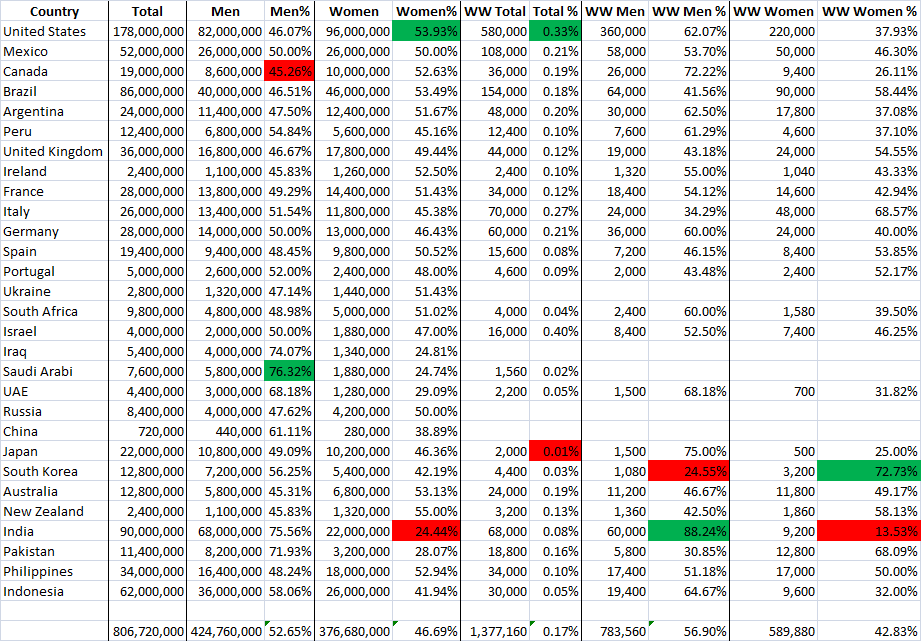With the announcement of Gal Gadot as Wonder Woman by Warner Bros., I wondered just how popular is Wonder Woman around the world and more interestingly, in each country. With there being over 200 countries in the world, I narrowed the focus a bit. I picked countries in various parts of the world that I think would be interesting and vary in results. I included nations from every continent (no not Antarctica) and a few that I wanted to choose, like Iran, wouldn’t return any data due to policies in the country (like Facebook being blocked).
Below is the raw data of all of the countries I looked at, and if folks want me to check out others, sound off in the comments below!
While men made up 52.65% of the population in these countries, they accounted for 56.90% of the Wonder Woman fans. If you remove the nations that didn’t have recordable Wonder Woman fans, the male population drops to 52.34%, but increases as Wonder Woman fans to 56.96%.
Green is for the highest value in that column and red is for the lowest. If the space is blank, then the results were below 1,000 fans.









Looking at the number of “fans”( i don’t think Facebook fandom is a reliable measure of devotion.i.e. I may have liked the ACLU FB page but i’m not a card member nor active supporter. that aside, its the best means of measurement we got), the production of this film should be in the hands of the director. DC needs do what they did for Batman and let the director be. pick someone like Daniel Woodrel or Alfonso Cuaron and let them do their thing. Personally, I can see the first wonder woman film as a sword and sandal/superhero origin story(god forbid they pull a He-Man/Green Lantern.). hoping it’s something special…
Daniel Woodrel is a fiction writer…not a director.
But… she has no head… at least not in that photo on the front page
How a site run by, and focusing on women in comics, manage to always crop photos of women to show off “the assets” is beyond me. SMH
In Venezuela Wonder Woman is very popular. Everyone knows who she is.
Any survey on attitudes about Wonder Woman has to distinguish between Wonder Woman the character and Wonder Woman the icon. From her days on the cover of Ms. Magazine to appearing on countless pieces of clothing and other stuff–people can have warm thoughts about her without thinking of her as a character at all. Betty Crocker is an icon, but she’s never been a character.
SRS
Hey Edward, so the Venezuela stats are:
Total: 10.8 million
Men: 5 million (46.3%)
Women: 5.8 million (53.7%)
Wonder Woman “fans”
Total: 13,600 (0.13%)
Men: 9,200 (67.65%)
Women: 4,400 (32.35%
As a format quibble, I think there’s an error in your green highlight of high value in the “WW Total %” column: the actual high value seems to be Israel’s 0.40%, not the US’s 0.33%.
That aside, I know I often make this comment about these exercises in recreational number-crunching based on Facebook fan data, but I’ll make it again here: what’s the *insight* to be gained from all this analysis? Why do any of these percentages matter?
I mean, would we look at this data and say because WW fans make up the largest share of FB fans in Israel, the U.S., Italy, Germany, and Argentina, then we would expect that the sales of Wonder Woman products in those countries should be particularly strong? And if they are not, are we saying that those countries represent an opportunity for focus for marketing WW product?
Are we saying because WW FB fans are most overwhelmingly female in South Korea, Pakistan, and Italy, then marketing of WW products in those regions might be most effective via platforms with strong female engagement?
Again…I appreciate the just plain fun of recreational number crunching, but that exercise can only be made more fun when it moves from just data-generation to actual insight. (By comparison, Devestator magazine’s convention exhibitor survey posted elsewhere on the blog does, IMO, did make a solid effort to add actionable insight to its analysis in a way that, generally, I don’t get from these exercises in FB analytics, fun as they might be.)
Correct on Israel, when I get a chance I’ll fix that.
The point of all of these are:
1) They show that comic fans aren’t just 20-30 something white guys, it’s a diverse crowd in taste, gender, age, etc.,
2) Because it’s diverse, the industry needs to look at how they’re marketing, instead of the one size fits all that’s been standard, and move into modern marketing that involves segmenting and targeted messaging,
3) That there is a massive amount of self-identified fans out there, and we should engage them,
4) It’s fun!
The fact I have marketing individuals contacting me as to how to use this data, and admitting this all has them thinking of how to do things differently, shows me it’s doing what it’s intended to.
I think it’s great that your work is inspiring marketers to devise more robust, segmented campaigns. It’d be great to hear more about how these data drove the creation of more sophisticated marketing (to the extent that those marketers are willing to share results, of course) as a bit of a case study, as it were, to underscore the high level insights you’ve identified.
Just came back to check on the discussion going on and yep she’s is fiction writer, i keep mixing her up with Debra Granik. she’s still a great director and i hope they tap her for the job.
Comments are closed.